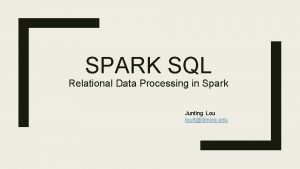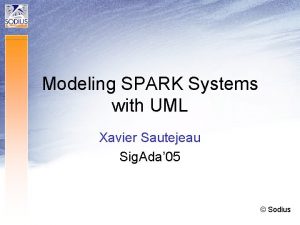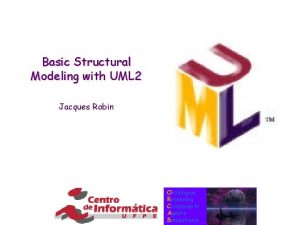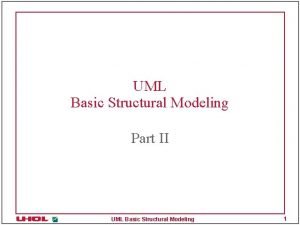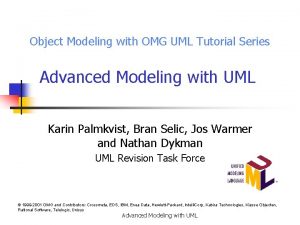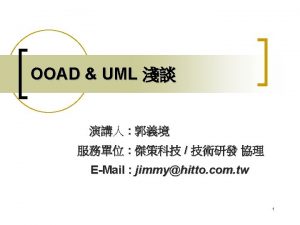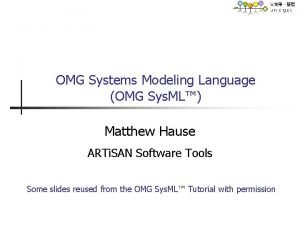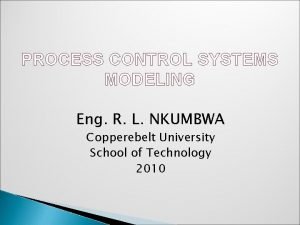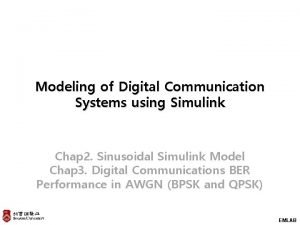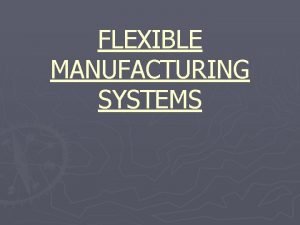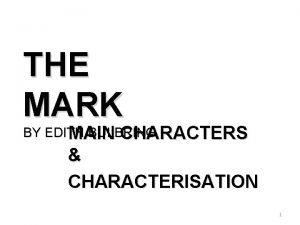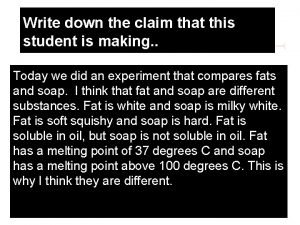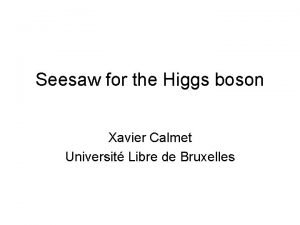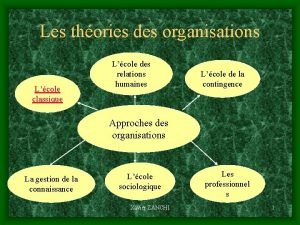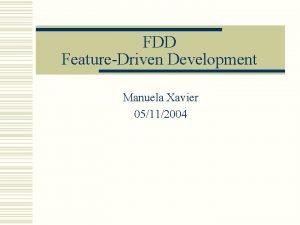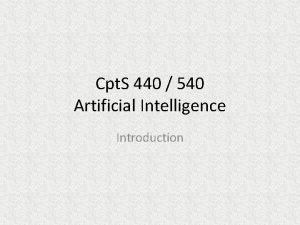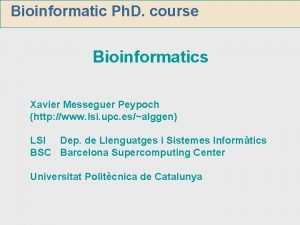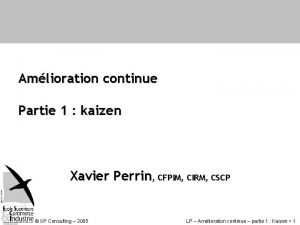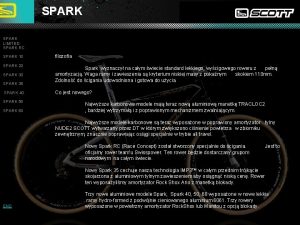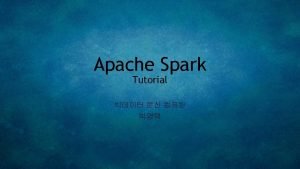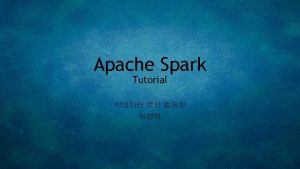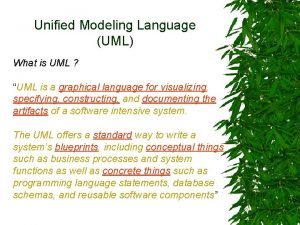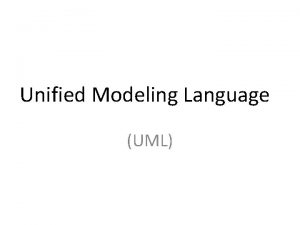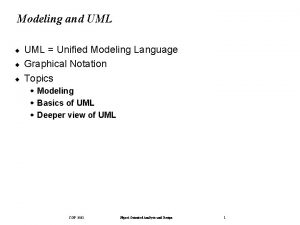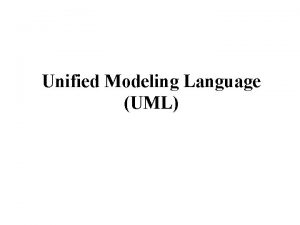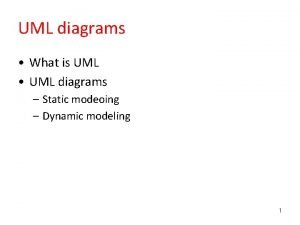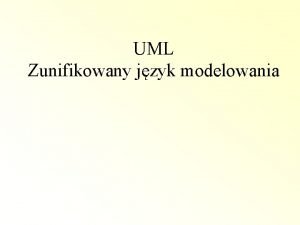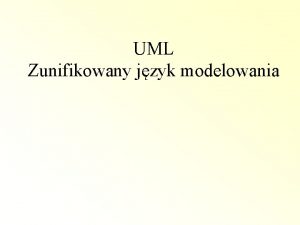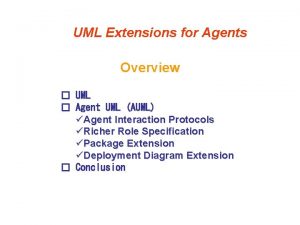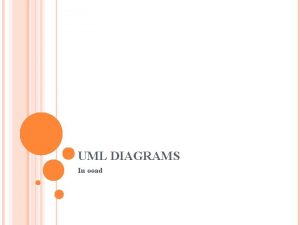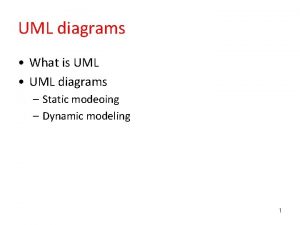Modeling SPARK Systems with UML Xavier Sautejeau Sig












![Mapping elements Customizing UML via profiles Profile element(s) [kind] SPARK construct UML construct <<Proof>> Mapping elements Customizing UML via profiles Profile element(s) [kind] SPARK construct UML construct <<Proof>>](https://slidetodoc.com/presentation_image/ddee83b0147e0d1fb1554e7ae4422c6f/image-13.jpg)






















- Slides: 35

Modeling SPARK Systems with UML Xavier Sautejeau Sig. Ada’ 05 © Sodius

Contents • Rationale • Mapping Overview • Tool support • Conclusion 2

Rationale • SPARK Overview • UML Overview • Why is a mapping useful ? Rationale - Mapping Overview - Tool Support - Conclusion 3

SPARK Overview • Description – Programming language • Safe(r) Ada subset • Comments with added-value safety semantics • Usage – Save money on defect detection – « Correctness by construction » • Further info – www. praxis-his. com/sparkada Rationale - Mapping Overview - Tool Support - Conclusion 4

UML Overview • Description – (Mainly) graphical notation • Usage – Model OO aspects of systems • Further info – www. uml. org Rationale - Mapping Overview - Tool Support - Conclusion 5

Why is a mapping useful ? • Combining perspectives – OO focus – Safety focus Better architecture • Smoothening transitions between development phases – Automate UML to SPARK transformation through code generation rules Rationale - Mapping Overview - Tool Support - Conclusion 6

Mapping overview • • Comparing UML and SPARK Mapping individual elements Mapping structure Evaluation criteria Rationale - Mapping Overview - Tool Support - Conclusion 7

Comparing UML and SPARK similarities • Domain – Represent SW development concepts and their relations • Composition rules – SPARK Ada based on a formal grammar • Defines the authorized combinations of syntactical elements – UML based on a metamodel • Defines the authorized combinations of modeling concepts Rationale - Mapping Overview - Tool Support - Conclusion 8

Comparing UML and SPARK differences • Goal – UML => modeling activities – SPARK => defect prevention • Audience – UML => humans – SPARK => computer Rationale - Mapping Overview - Tool Support - Conclusion 9

Mapping individual elements • "Natural" mapping of main concepts • Customizing UML via profiles • Enhancing the fit Rationale - Mapping Overview - Tool Support - Conclusion 10

Mapping elements "Natural" mapping SPARK construct UML model element Package Class | Package Operation Variable Attribute Annotation Constraint | Dependency | Tagged. Value | Stereotype Some possible equivalences from SPARK to UML Rationale - Mapping Overview - Tool Support - Conclusion 11

Mapping elements Customizing UML via profiles • Native UML not rich enough to represent SPARK systems • Profile – set of stereotypes, tagged values and constraints – To bring additional descriptive power to the UML notation Rationale - Mapping Overview - Tool Support - Conclusion 12
![Mapping elements Customizing UML via profiles Profile elements kind SPARK construct UML construct Proof Mapping elements Customizing UML via profiles Profile element(s) [kind] SPARK construct UML construct <<Proof>>](https://slidetodoc.com/presentation_image/ddee83b0147e0d1fb1554e7ae4422c6f/image-13.jpg)
Mapping elements Customizing UML via profiles Profile element(s) [kind] SPARK construct UML construct <<Proof>> [stereotype] Proof type | Proof Operation Type | Operation Own. Mode [tagged value, Enum (None, In, Out)] Own variable mode Attribute global. Spec, global. Body [tagged value, String] Global annotation(s) Operation <<Global>> [stereotype] Global annotation(s) Dependency ( from operation to attribute) SPARK Profile Candidate Elements Rationale - Mapping Overview - Tool Support - Conclusion 13

Mapping elements Enhancing the fit Stack class operations properties A UML Model of the Stack class Rationale - Mapping Overview - Tool Support - Conclusion 14

Mapping elements Enhancing the fit Implicit “this” parameter Stack class operations passing mode in properties UML can only translate to “in” or “in out” in SPARK Rationale - Mapping Overview - Tool Support - Conclusion 15

Mapping elements Enhancing the fit -- partial specification of the Stack class package Stacks is type Stack is private; procedure Clear(S: out Stack); --# derives S from ; Stack class operations properties procedure Pop (S : in out stack; X : out Integer); --# derives S, X from S; procedure Push (S : in out stack; X : in Integer); --# derives S from S, X; end Stacks; Rationale - Mapping Overview - Tool Support - Conclusion 16

Mapping structure • Declaration order considerations • Composition rules Rationale - Mapping Overview - Tool Support - Conclusion 17

Mapping structure • A definition declaration order – “A metamodel is an “abstract language” for describing different kinds of data; that is, a language without a concrete syntax or notation. " – OMG, Meta Object Facility, Version 1. 4 • In programming languages, concrete syntax is essential – for compilation – for static-analysis (core of SPARK) Rationale - Mapping Overview - Tool Support - Conclusion 18

Mapping structure declaration order package Stacks is type Stack is private; private Stack_Size : constant : = 100; type Pointer_Range is range 0. . Stack_Size; subtype Index_Range is Pointer_Range range 1. . Stack_Size; type Vector is array (Index_Range) of Integer; type Stack is record Stack_Vector: Vector; Stack_Pointer: Pointer_Range; end record; end Stacks; Rationale - Mapping Overview - Tool Support - Conclusion 19

Mapping structure declaration order package Stacks is type Stack is private; This type declaration depends on the “Stack_Size” constant declaration private Stack_Size : constant : = 100; type Pointer_Range is range 0. . Stack_Size; subtype Index_Range is Pointer_Range range 1. . Stack_Size; type Vector is array (Index_Range) of Integer; type Stack is record Stack_Vector: Vector; Stack_Pointer: Pointer_Range; end record; end Stacks; How do you represent this declaration order dependency in UML ? Rationale - Mapping Overview - Tool Support - Conclusion 20

Mapping structure declaration order • Inherent to SPARK Grammar – Built-in total ordering • UML – Only partial ordering • For elements of the same kind (e. g. attributes) Rationale - Mapping Overview - Tool Support - Conclusion 21

Mapping structure composition rules • Operations membership – Class members in UML – Package or other operation member or standalone in SPARK • Operation as a namespace – In SPARK/Ada – Not in UML • UML is class-centric Rationale - Mapping Overview - Tool Support - Conclusion 22

Evaluation criteria • No canonical mapping • Criteria are a combination of – Semantic proximity • E. g « UML constraint SPARK annotation » vs « UML tagged value SPARK annotation » – Workflow integration • process • people • tools Rationale - Mapping Overview - Tool Support - Conclusion 23

Tool support • Evaluation criteria – Dedicated/customizable user interface – Generators/leveraging model data – Compensating UML limitations • Implementation – Rhapsody in Ada (Ri. A) Rationale - Mapping Overview - Tool Support - Conclusion 24

Evaluation Criteria dedicated user interface • Writer/Input Perspective – Facilitate the modeling of SPARK aspects of a model • Reader/Output perspective – Highlight « SPARKness » of elements on diagrams Rationale - Mapping Overview - Tool Support - Conclusion 25

Evaluation Criteria Leveraging model data • Generate – Code – Documentation – Make files – CM commands –… Rationale - Mapping Overview - Tool Support - Conclusion 26

Evaluation Criteria Compensating UML limitations • Via profiles • By offering more than a strictly UML compliant CASE tool Rationale - Mapping Overview - Tool Support - Conclusion 27

Implementation on Ri. A User interface • « Model-oriented » and « Captureoriented » styles – Annotation = dependencies + stereotypes + tags – Annotation = tag • Graphical(UML) vs Textual(SPARK) Rationale - Mapping Overview - Tool Support - Conclusion 28

Implementation on Ri. A Code generator • UML Meta-Model based implementation – Rules-based generation engine – Flexible, but limited by the MM itself • Unusual approach for SPARK – Limit the amount of auto-generated code – To limit the information-flow – Enforces design based on conscious decisions from user Rationale - Mapping Overview - Tool Support - Conclusion 29

Implementation on Ri. A Interfacing with the examiner • Optimize user workflow • Integrate Examiner into Rhapsody – Generate examiner commands – Invoke directly from CASE tool – Redirect output • Error navigability Rationale - Mapping Overview - Tool Support - Conclusion 30

Conclusion • Concepts promoted by SPARK – Make Ada a better language – Are applicable across a large abstraction spectrum • From business logic domain (information flow analysis) • Down to implementation (proof annotations) – Are just as important as OO aspects Rationale - Mapping Overview - Tool Support - Conclusion 31

Conclusion • Static analysis integration in UML – Requires an evolution of the Meta Model • From a platform independent perspective – Information flow is applicable at a high level of abstraction • From a platform specific perspective – Proof relies on code and not on mere specs – Justified by current model driven practices • MDA technologies requalify some systems aspects as valuable modeling flow sources Rationale - Mapping Overview - Tool Support - Conclusion 32

Conclusion • Exploitable mapping – native UML + Profile – Associated tooling • Room for progression Rationale - Mapping Overview - Tool Support - Conclusion 33

A word of Thanks 34

Questions ? Xavier Sautejeau xsautejeau@sodius. com
 Spark sql: relational data processing in spark
Spark sql: relational data processing in spark Spark systems limited
Spark systems limited Helen c erickson
Helen c erickson Relational vs dimensional data modeling
Relational vs dimensional data modeling Structural modeling in uml
Structural modeling in uml Uml
Uml Uml modeling tutorial
Uml modeling tutorial Uml 物件圖
Uml 物件圖 Uml 1 vs uml 2
Uml 1 vs uml 2 Omg systems modeling language
Omg systems modeling language Mathematical modeling of mechanical systems
Mathematical modeling of mechanical systems Control systems modeling
Control systems modeling Modeling of digital communication systems using simulink
Modeling of digital communication systems using simulink Modeling of digital communication systems using simulink
Modeling of digital communication systems using simulink Manufacturing systems modeling and analysis
Manufacturing systems modeling and analysis Object-oriented systems analysis and design using uml
Object-oriented systems analysis and design using uml Etties character in the mark
Etties character in the mark Xavier van rooyen
Xavier van rooyen Xavier barberis
Xavier barberis Xavier aubry
Xavier aubry Henri-françois-xavier de belsunce de castelmoron
Henri-françois-xavier de belsunce de castelmoron Mehek fin
Mehek fin Xavier gimeno
Xavier gimeno French royal lineage
French royal lineage Mdvpn
Mdvpn Who killed mr xavier answer key
Who killed mr xavier answer key Xavier calmet
Xavier calmet Hostilio xavier ratton neto
Hostilio xavier ratton neto Xavier zanchi
Xavier zanchi Etica kantiana
Etica kantiana 05112004 color
05112004 color Ai 440
Ai 440 Mr xavier mystery claim evidence reasoning
Mr xavier mystery claim evidence reasoning Xavier messeguer
Xavier messeguer Xavier seiso
Xavier seiso Xavier naidoo rausammy naidoo
Xavier naidoo rausammy naidoo
